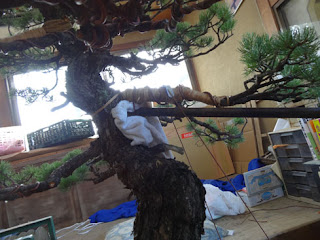Here is another Goyomatsu i could style.
As you can see the tree needed some heavy bending in the first 3 branches , the
branches needed to go more down to create a more natural and old looking tree.
How did i bend it?
Because it wasnt easy to use the jack at this position , i used a towel to protect the bark and put a iron barn on it , attached the branch and the iron with wire and bend the branches down.
After i thought i was on max that i could do , Fukita-san said they had to go much lower and if a small crack would appear between branch and trunk it wouldnt damage the health to much.
So i did.
Because it wasnt easy to use the jack at this position , i used a towel to protect the bark and put a iron barn on it , attached the branch and the iron with wire and bend the branches down.
After i thought i was on max that i could do , Fukita-san said they had to go much lower and if a small crack would appear between branch and trunk it wouldnt damage the health to much.
So i did.
After the bending i wired the tree and look what i found , the trees inhabitant a little frog.
It stayed there untill i had to wire the head of the tree and got scared , jumped and gone he or she was.
When i was finished the tree looked like this...
























